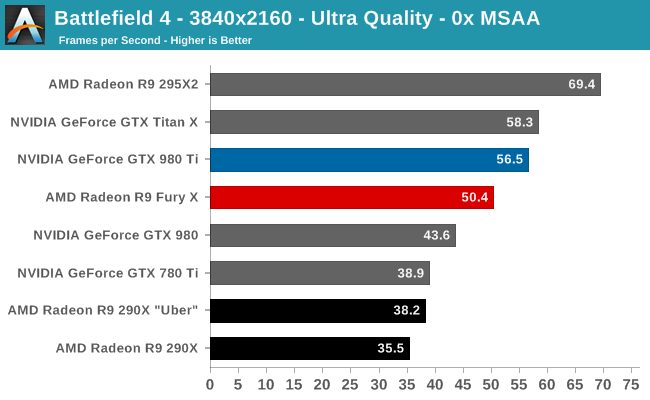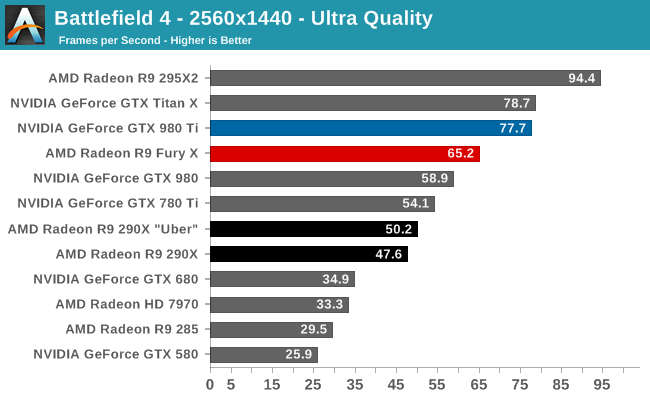The AMD Radeon R9 Fury X Review: Aiming For the Top
by Ryan Smith on July 2, 2015 11:15 AM ESTBattlefield 4
Kicking off our benchmark suite is Battlefield 4, DICE’s 2013 multiplayer military shooter. After a rocky start, Battlefield 4 has since become a challenging game in its own right and a showcase title for low-level graphics APIs. As these benchmarks are from single player mode, based on our experiences our rule of thumb here is that multiplayer framerates will dip to half our single player framerates, which means a card needs to be able to average at least 60fps if it’s to be able to hold up in multiplayer.



As we briefly mentioned in our testing notes, our Battlefield 4 testing has been slightly modified as of this review to accommodate the changes in how AMD is supporting Mantle. This benchmark still defaults to Mantle for GCN 1.0 and GCN 1.1 cards (7970, 290X), but we’re using Direct3D for GCN 1.2 cards like the R9 Fury X. This is due to the lack of Mantle driver optimizations on AMD’s part, and as a result the R9 Fury X sees poorer performance here, especially at 2560x1440 (65.2fps vs. 54.3fps).
In any case, regardless of the renderer you pick, our first test does not go especially well for AMD and the R9 Fury X. The R9 Fury X does not take the lead at any resolution, and in fact this is one of the worse games for the card. At 4K AMD trails by 8-10%, and at 1440p that’s 16%. In fact the latter is closer to the GTX 980 than it is the GTX 980 Ti. Even with the significant performance improvement from the R9 Fury X, it’s not enough to catch up to NVIDIA here.
Meanwhile the performance improvement over the R9 290X “Uber” stands at between 23% and 32% depending on the resolution. AMD not only scales better than NVIDIA with higher resolutions, but R9 Fury X is scaling better than R9 290X as well.










458 Comments
View All Comments
Samus - Saturday, July 4, 2015 - link
Being an NVidia use for 3 generations, I'm finding it hard to ignore this cards value, especially since I've invested $100 each on my last two NVidia cards (including my SLI setup) adding liquid cooling. The brackets alone are $30.Even if this card is less efficient per watt than NVidia's, the difference is negligible when considering kw/$. It's like comparing different brand of LED bulbs, some use 10-20% less energy but the overall value isn't as good because the more efficient ones cost more, don't dim, have a light buzz noise, etc.
After reading this review I find the Fury X more impressive than I otherwise would have.
Alexvrb - Sunday, July 5, 2015 - link
Yeah a lot of reviews painted doom and gloom but the watercooler has to be factored into that price. Noise and system heat removal of the closed loop cooler are really nice. I still think they should launch the vanilla Fury at $499 - if it gets close to the performance of the Fury X they'll have a decent card on their hands. To me though the one I'll be keeping an eye out for is Nano. If they can get something like 80% of the performance at roughly half the power, that would make a lot of sense for more moderately spec'd systems. Regardless of what flavor, I'll be interested to see if third parties will soon launch tools to bump the voltage up and tinker with HBM clocks.chizow - Monday, July 6, 2015 - link
Water cooling if anything has proven to be a negative so far for Fury X with all the concerns of pump whine and in the end where is the actual benefit of water cooling when it still ends up slower than 980Ti with virtually no overclocking headroom?Based on Ryan's review Fury Air we'll most likely see the downsides of leakage on TDP and its also expected to be 7/8th SP/TMU. Fury Nano also appears to be poised as a niche part that will cost as much if not more than Fury X, which is amazing because at 80-85% of Fury X it won't be any faster than the GTX 980 at 1440p and below and right in that same TDP range too. It will have the benefit of form factor but will that be enough to justify a massive premium?
Alexvrb - Monday, July 6, 2015 - link
You can get a bad batch of pumps in any CLC. Cooler Master screwed up (and not for the first time!) but the fixed units seem to be fine and for the units out there with a whine just RMA them. I'm certainly not going to buy one, but I know people that love water cooled components and like the simplicity and warranty of a CL system.Nobody knows the price of the Nano, nor final performance. I think they'd be crazy to price it over $550 even factoring in the form factor - unless someone releases a low-profile model, then they can charge whatever they want for it. We also don't know final performance of Fury compared to Fury X, though I already said they should price it more aggressively. I don't think leakage will be that big of an issue as they'll probably cap thermals. Clocks will vary depending on load but they do on Maxwell too - it's the new norm for stock aircooled graphics cards.
As for overclocking, yeah that was really terrible. Until people are able to tinker with voltage controls and the memory, there's little point. Even then, set some good fan profiles.
Refuge - Thursday, July 23, 2015 - link
To be honest, the wine I've seen on these isn't anything more than any other CLC I've ever seen in the wild.I feel like this was blown a bit out of proportion. Maybe I'm going deaf, maybe I didn't see a real example. I'm not sure.
tritiumosu3 - Thursday, July 2, 2015 - link
"AMD Is nothing if not the perineal underdog"...
perineal =/= perennial! You should probably fix that...
Ryan Smith - Thursday, July 2, 2015 - link
Thanks. Fixed. It was right, and then the spell-checker undid things on me...ddriver - Thursday, July 2, 2015 - link
I'd say after the Hecktor RuiNz fiasco, "perpetual underdog" might be more appropriate.testbug00 - Sunday, July 5, 2015 - link
Er, what fiasco did Hector Ruiz create for AMD?Samus - Monday, July 6, 2015 - link
I'm wondering the same thing. When Hector Ruiz left Motorola, they fell apart, and when he joined AMD, they out-engineered and out-manufactured Intel with quality control parity. I guess the fiasco would be when Hector Ruiz left AMD, because then they fell apart.